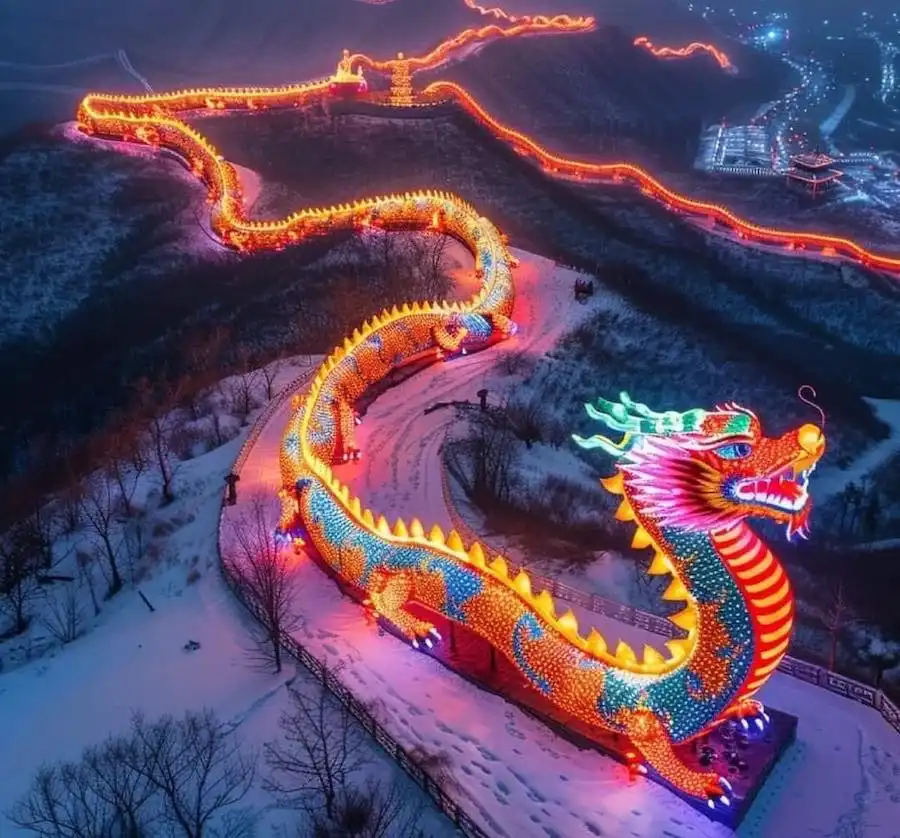The Great Wall of China: Envisioning the Great Dragon
Spanning thousands of miles across northern China, the Great Wall stands not only as a marvel of engineering and a symbol of enduring strength but also as a poetic embodiment of a great Chinese dragon, winding its way through deserts, mountains, and plains. This monumental structure, with a history that stretches over two millennia, has protected and defined the Chinese civilization, much like the mythical dragon that represents power, wisdom, and protection in Chinese culture.
A Living Dragon Across the Landscape

The Great Wall’s comparison to a dragon is deeply rooted in Chinese artistic and poetic traditions. The dragon, a benevolent symbol in Chinese mythology, represents auspicious power, and the ability to control water, rainfall, typhoons, and floods. Likewise, the Great Wall traverses China’s vast landscape, its path dictated by the contours of the land, climbing steep ridges, and descending into deep valleys, much like a dragon moving with grace and purpose.
The wall’s construction, which began as early as the 7th century BC and continued until the 17th century AD, involved millions of workers: soldiers, peasants, and prisoners. They built the wall not as a single, unbroken structure but as a series of walls, fortifications, and watchtowers, adapting to the natural environment. Over centuries, these efforts culminated in the sprawling edifice known today, a testament to the collective strength and will of the Chinese people, echoing the dragon’s legendary resilience.
Symbolism and Significance
Just as the dragon is revered for its wisdom and strength, the Great Wall embodies the strategic acumen and enduring spirit of the Chinese civilization. It served as a formidable barrier against invasions, a platform for signaling and communication through smoke and fire, and a transportation corridor facilitating the movement of troops and supplies. Moreover, the Wall demarcated the cultural boundary between the agrarian Chinese civilization and the nomadic tribes of the north, symbolizing the divide between order and chaos, civilization and barbarism, in much the same way the dragon straddles the line between the earthly and the divine.

The Great Wall Today: A Dragon Awakens
Today, the Great Wall is recognized as one of the New Seven Wonders of the World, drawing visitors from across the globe. Sections like Badaling and Mutianyu near Beijing offer restored glimpses of the Wall’s majesty, while more remote areas like Jiankou and Gubeikou present a wild, untamed beauty akin to a dragon resting in its natural habitat. The Wall is not only a historical relic but a living symbol of China’s ongoing story, inspiring awe and reverence in equal measure.
Visitors walking along the ramparts can’t help but feel a connection to the countless individuals who built, guarded, and walked these same stones. The experience is a powerful reminder of the enduring legacy of China’s history, culture, and achievements, encapsulated in the sinuous form of the Great Wall—a great dragon lying in wait, a guardian of the past, and a witness to the future.
A Monument to Human Endeavor and Imagination

The Great Wall of China, as a great dragon winding across the landscape, is more than an architectural feat; it is a bridge connecting the physical and the mythical, the historical and the poetic. It stands as a monument to human endeavor, imagination, and the unbreakable spirit of a civilization that has, through centuries, resembled the dragon’s wisdom, power, and protective grace. In the silhouette of the Wall, one can see not just stone and mortar, but the heartbeat of China itself—a great dragon, eternal and awe-inspiring.



















